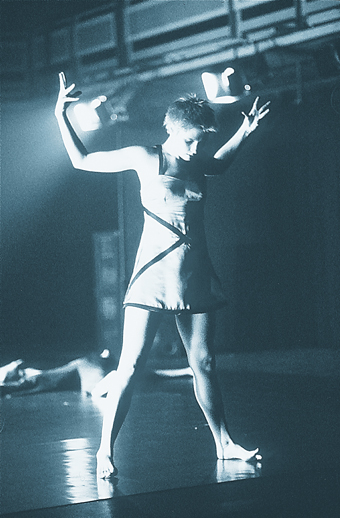Cyberistic power and human frailty
Eleanor Brickhill joins the dots in new works from Shelley Lasica and Chunky Move

Zero, Chunky Move, Bodyparts
Despite their different backgrounds, choreographers Shelley Lasica, Lucy Guerin and Gideon Obarzanek seem to have encapsulated if not the actual spirit of the 90s, then one manifestation which is traceable through their works, reflecting a particular cyberistic quality in our aesthetic culture.
I read the program notes for Shelley Lasica’s action situation with a quiver of doubt at what seemed like overly formal theorising of the work, in the “diffused spectatorship”, “mixed sourcing” and the “tension between the illusionistic space and time of narrative and the ‘presentness’ of physical actions unfolding through real time and space.”
As it turned out, there was a beautifully unexpected and really satisfying irony in action situation which undercut such dryness. All of the above indications might well be present in the work, but Lasica’s wit, in the stage and costume designs particularly, created a drama of small events, a soap opera of moves and relationships to rival Neighbours.
Squares of dressing room lights to the front and side of the stage form the shape of mirrors in which the dancers might watch themselves performing this drama. Their actions seem at first totally unco, with 3 rangy women on stage apparently either getting together or not, sidling around, looking askance at each other, organising their spatial and intentional relationships with all the human doubt, wile and surprise one might reserve for emotional bonds.
The costumes too are out there, the epitome of 90s irony. The look is poor-girl schizoid, clothes which seem to have been pinned on by someone very young, who would rather be seen as proudly enslaved to the necessities of poverty than the trivialities of fashion. Sleeves are all odd lengths, fabric is draped in neither skirts nor pants, but something more indeterminate. They have hoods too, a signature of cred. Perhaps it’s the fact that audiences don’t often get to witness the ironies of contemporary behavioural ethics and demeanour in dancing which provides the humour.
That same gauche, patched-together quality was also evident in Lucy Guerin’s work, Zero, performed by dancers from Melbourne-based Chunky Move, although there was a further choreographic complexity here which created a different sort of pattern. In the tradition of Bladerunner, Zero brought into clearer focus those cyberistic currents running through our visual/emotional culture. In any event, the movement style has become recognisable: a human body might be an invaded thing, having a kind of disembodied action, its own initiative almost renounced, in a fusion of fragile flesh with an inhuman and indestructible will. There is so much sex in the dancers’ doll-like actions, their bodies so much a collection of will-less animated limbs, their stance speaking of brutalised naivety.
I don’t think this is entirely what Zero is about, but it is what has stayed with me. The women often stand splay-footed and stiff-kneed, pigeon-toed, pelvis thrust forward, arms back, fingers held and open like a doll’s. There are tightly bound sequences, legs turned out in wide fourths, crossed wrists like bondage, movements repeated on-off, like faulty electrical wiring, arms which gesture to classical ports de bras in the same way as a 4 year old child’s might. There is an ethic being aped here, a culture being cannibalised. It is really this child-like capacity to take in, adapt and survive with whatever is at hand which seems to be indicated, and comes across in the end.
Similarly, in All The Better To Eat You With, Gideon Obarzanek uses elements of Little Red Riding Hood to examine some fragments of interweaving fantasies which hang around this story and give it power. Here, rape and murder, or at least brutalisation and the death of innocence, become lessons for a child to learn through the monstrous toys and other fantasy characters that inhabit her life. The opening scene shows a naked woman lying on the floor, and a suited man backing away, his spastic actions reflecting a kind of unspeakable horror at whatever act he has just committed. The accompanying sound collage featured both a child speaking the familiar lines, “Grandma, what big ears you have…what big teeth you have…”, and a melody from Amazing Grace, “…was blind but now I see.” This man comes back soon as the Wolf to seduce the child away from her toys and her grandma.
There are other fantasies, too. The grandmother figure is killed many times over, and then magicked back to life by the child’s spells; there is also a scene of sexual fantasy, grandma dreaming, the wolf stripping her of her clothes. At times we wonder just whose fantasy is being played out, Grandma’s, the Wolf’s or Little Red Riding Hood’s. In any case, the child in the tiny red polka dot frock finally makes an effort to preserve her innocence, fights and overpowers the Wolf, but at a cost. The closing scene shows her back in the same fallen position on the floor, perhaps not dead, but certainly no longer innocent. “I cannot feel, I cannot feel…” repeated over and over again gives us the sense that while brutalisation has occurred and she is left insensitive, she is nevertheless alive, if unable to respond. I was reminded strongly of that same expression of cyberistic power and human frailty that permeates our culture, simultaneously protective and exploitative, a fusion of will and terminal weakness.
–
action situation, Shelley Lasica, The Performance Space, August 24 – 28; Chunky Move, Body Parts: Lucy Guerin, Zero, Gideon Obarzanek, All the Better to Eat You With, Drama Theatre, Sydney Opera House, August 31 – September 4
RealTime issue #33 Oct-Nov 1999 pg. 10






